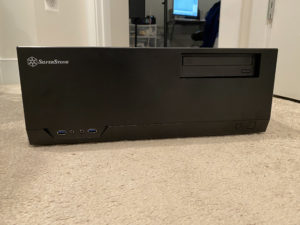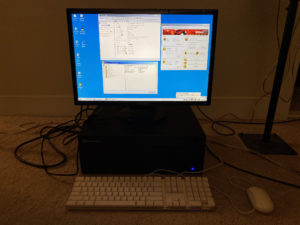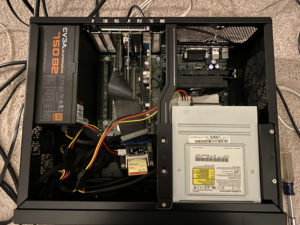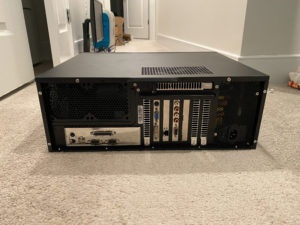
While building my Ultimate PowerMac G4, the Pentium III build wasn’t supposed to happen. However, it did when I decided to buy a Geforce 4 Ti 4600 PC version to flash. As you know, that didn’t quite work out as I shared in my previous post.
Thankfully, I managed to buy a Mac version of the Geforce 4 Ti 4600, which are not only rare, but usually go for over $200 on Ebay. While there are Mac part stores claim to have them, they don’t have any in stock. I managed to snag a working one for $150 plus $20 shipping from the owner of Mac OS 9 Lives. I will be sharing benchmarks once it arrives in the mail, and I get the chance to install it.
With that, since I needed a computer with an AGP port, I decided to build a retro gaming computer. As expected, my father threw out the Windows 98 computer from my childhood. Even if I have it, it doesn’t have an AGP port and it’s slow, so I needed to build a better one anyway. This computer is named after Haru Urara, a character from Uma Musume and the Japanese racing horse of the same name.

As for the parts I decided to pick out, I decided to build a reverse sleeper retro gaming PC. This is taking a modern PC case and using old computer parts inside it. Of course, there are some limitations of doing this as you can’t use front panel USB and audio ports. Not to mention, modern power supplies these days have weaker 5v rail. This is bad since older CPUs relies on it. I went with a Silverstone Grandia GD09. While it’s meant as a home theater PC case, it gave that classic desktop look when you put a monitor on top of it.
Of course, picking the right hardware was a challenge. On the first attempt, I bought a motherboard combo with a Pentium III CPU and RAM. However, I found out that the motherboard was an OEM motherboard that won’t post at all. Yes, I tried different RAM, but I couldn’t get it to post, so I returned it for a refund. The second try, I didn’t even get the right item and returned it for a full refund.

After being frustrated, I decided to pay a little more for a old-new stock Intel SE440BX-2. That did the trick, and everything was included. This includes the Slot 1 retention clips, the IO shield, IDE and floppy drive cable. I also decided to go with a 700 MHz Pentium III processor, which the motherboard supported.
While it was tricky to install the IO shield, I eventually got it on. I initially went with an IDE to SD card adapter to install the operating system, but it didn’t work out as planned. Files keep getting corrupt. With that, I returned it for an IDE to CF card adapter. However, that didn’t recognize with the internal IDE controller. The internal IDE controller does not like drives over 60 GB in size. Installing a Promise Ultra 100 Controller resolved these issues. Also, it’s probably be possible to install an actual SSD with a SATA to IDE adapter as long it’s 128 GB or smaller.
So, why did I go with a Pentium III build with all the challenges. I do not want to build a Pentium 4 machine, even if the parts are cheaper. After all, the Pentium 4 is a vastly inferior processor and produces a lot of heat. As for Athlon builds, they require a power supply with a strong 5v rail. Since I want to use a modern power supply, the Pentium III is a no-brainer. Also, the SE440BX-2 has two ISA slots, which most modern Pentium III motherboards lack. An ISA slot allows me to install an AWE32/64 if I want to.
With that, my build is complete. The final build consists of the following:
- Intel SE440BX-2 Motherboard
- Intel Pentium III Slot-1 700 MHz/256 KB L2 Cache/100 MHz FSB Processor
- EVGA SuperNova 750 W B2 80 Plus Bronze Power Supply (Taken from my 2nd ESXi host, which I upgraded to a Seasonic Focus Platinum 750W Power Supply)
- Sandisk Extreme 64 GB Compact Flash Card connected to a Promise Ultra100 ATA Controller
- Samsung DVD/CD-RW Combo Drive taken from an old Dell Dimension
- 512 MB of PC100 SDRAM (2x 128 MB, 1x 256MB)
- ATi Radeon 8500 64 MB Video Card
- M-Audio Audiophile 2496 Sound Card
- Startech Gigabit Ethernet PCI Adapter



Overall, it scores about 4800 in 3DMark01 SE. The CPU is a bottleneck, but it runs most games I want to run from the early 2000s fine at the highest settings at 1024 x 768 resolution. It would benefit greatly with a 1 GHz Pentium III, but those are expensive and probably only give a marginal improvement in performance. I used Windows 2000 over 98 since it’s more stable and supports more games. Aside from that, this build will mostly remain the same, unless I find a faster processor at a decent price.
Leave a Reply